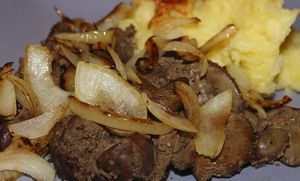
When was the last time you ate a bowl of Jell-O? All that wiggly jiggly fun bouncing around on your plate has a lot more going for it than you know. The main problem with Jell-O, specifically of course, is the massive amounts of sugar, artificial flavors and colors. But the basic wiggly jiggly of Jell-O comes from gelatin, and gelatin is a powerful tool we can use in our healing journey.
Now years ago the belief was that gelatin was a worthless protein because it is deficient in several essential amino acids. Essential amino acids have to be consumed from your diet because your body cannot make them on its own. This is true, so gelatin is not a good idea as a sole food source. But that completely misses the huge value of the specific proteins in gelatin for use in our bodies. What was missed years ago was that gelatin did provide one amino acid that our body needs a lot of but can only make a small amount of – glycine. Our bodies need about 10 grams of glycine a day, but can only synthesize 2 to 3 grams.

Where does gelatin come from? It comes from the connective tissue in the body – the tendons, ligaments, joints, and most importantly the collagen in the skin. The amino acids that form the collagen in the skin are what becomes gelatin when it is derived commercially. About half the protein in the body is connective tissue and the other half is the muscle meat that moves us around in the world.
Nutrition studies have only looked at the impact of the proteins we eat on our muscle mass as this is easy to measure. No one looks at our connective tissue. In fact connective tissue was largely ignored by medicine and research until the baby boomer population started getting older and critical connective tissues, like knee joints, started wearing out. Traditional medicine still ignores the health of the joints and instead has come up with clever metal replacement joints. But Boomers want something more. They want to have good joints without having to have surgery. So research dollars are being spent on how to keep connective tissue, like joints, functional. Spin-offs of this research have resulted in better understanding of connective tissue in general.

One particular research finding that particularly caught my interest resolved a long-standing conflict for me in perceiving a grain-free diet as a healthy option. Generally this option results in higher meat consumption, and although this lifestyle works, there are negative health consequences to how this plays out in our culture. People on high red meat diets have shorter life spans. Science has related this to the higher consumption of the essential amino acid methionine, which is found abundantly in meats, grains, and peanuts. Although it is essential, it appears that too much is as bad as not enough. However, the negatives to the higher meat diet disappear when connective tissue high in the amino acid glycine is added to the diet. Our Western practice of eating only the muscle meats and not the organs and connective tissue is to blame for the negative consequences to a high meat diet. In plain English, if you are going to eat meat, you must include organ and connective tissue with it.

What am I talking about here? I am talking about gelatin! Gelatin is what is in the connective tissue that makes the health move to get off grains work. This means eating bone broth, organ meats, tendons, and lots of stuff we consider disgusting. But the key ingredient from these tissues is palatable to us – gelatin, or the stuff of Jell-O. We could almost think of gelatin (the glycine it contains) as a necessary vitamin that no one has told us about. Gelatin contains the glycine we need to make the collagen that holds our body together.
Diets rich in collagen/glycine demonstrate more rapid repair from joint and tendon injuries and a decrease in joint pain in athletes. Collagen supplementation speeds up healing time as collagen forms the matrix that new cells need to repair and replace damaged tissue. Taking a mug of hot bone broth rich in gelatin is shown to increase sleep quality, yet during the day it reduces daytime sleepiness in folks that have missed sleep.

Probably the most important point about taking collagen as a supplement for many people is because of its effects on skin. It is collagen that gives the shape and elasticity to our skin. Taking supplemental collagen/gelatin reduces skin cracking, wrinkling, and improves skin elasticity. Skin is mostly made of collagen.
So how can we get more collagen/gelatin/glycine in our diet? Well you know how when you cook meats the pan fills up with yummy meat juice? That meat juice is full of gelatin. We are getting gelatin when we turn that juice into gravy or use that juice as a rich stock to base a soup in. Muscle meats are low in gelatin. It is the tough organ meats and joints that require extra cooking time that are high in collagen/gelatin. That crunchy white cap on the ends of the bones – the cartilage – is high in collagen. Chew up the end caps on bones or save them and slow cook them in a crock-pot to make bone broth.

Way back (last week) when the government was mistakenly telling us that saturated fat was bad for us, people started taking the skin off their pieces of chicken. Well guess what – skin is full of collagen, so eat it up. Let the uninformed continue to eat their chicken breast without the skin – I will bake up a pan full of chicken wings and actually enjoy the chicken. The skin is good for you if it comes from healthy chicken raised without poisons in a natural environment.
Last of all you can go straight to the source and consume actual powdered gelatin or use a collagen hydrolysate in your smoothie. Add gelatin to any number of food products. I add it into my homemade yogurt. I will take a stevia sweetened drink and add gelatin to it then heat it up on the stove until the gelatin melts then put it into the fridge to let it set up into a tasty gelatin desert without the sugar. I even made gelatin

candies for Ellen on Valentine’s Day. There are lots of ways to include more gelatins in your diet.
Since increasing the gelatin levels in your diet have been shown to increase lifespan and decrease many diseases, I think this is a no-brainer for healthy lifestyle enhancement.
